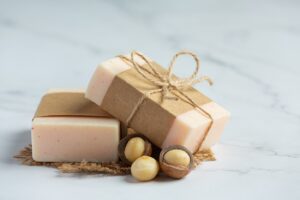How To Insulate Cold Process Soap:
Oftentimes when soap-making, an overlooked aspect is proper insultation. When we began the process we focused on learning how to make soap, recipe development, blending fragrances, understanding trace, picking our molds, and overall aesthetics of our soap. We paid little attention to what insultation could do for our soaps after our batter was poured and the waiting game had begun. In this post we’ll explore, how to insulate cold process soap.

As you become more familiar with soaping, you realize just how crucial temperature plays a part at every step. Whether that be the temperature at which you mix your oils and lye solution, to whether or not you force gel after your batter is poured and saponification begins.
Related Article: How to Store Cold Process Soaps, Cutting and Curing: Let’s Chat About It!
What can temperature dictate in soap making?
Colors:
One way temperature effects soap is the color. Forcing your soap through “gel phase” provides brighter more vibrant colors (which may or may not be what you’re looking for).
Unmolding:
More often then not, if batter continues through gel phase, you will be unmolding your soap faster from the mold.
Glycerin Rivers:
Soaping at too high of temperature, and forcing gel, can lend itself to causing glycerin rivers, especially with certain additives.
Trace:
If you soap at higher temperatures, your batter may trace faster or accelerate more so then if you soaped at room temperature.
Scent:
Temperature can effect your scents and whether it lasts in homemade cold process soap, especially with certain fragrances and/or essential oils.
Gloss:
Increased temperature, or forcing gel can also have your soap looking slightly translucent.
Limit soda ash:
Reaching full gel phase may also inhibit or decrease chances of soda ash!
What exactly are we referring to when we say insulating our soaps?
By insulating your soap, you’re doing exactly what you may be thinking, you’re attempting to enclose it to increase it’s temperature. The saponification process is endothermic, pulls in heat from the surroundings, so insulating it’s environment or even placing it in the oven, helps fully gel your soap.
Keep in mind this is not what all soapers want, and this is not what may be best for all soaps. Oftentimes, it’s based on personal preference and the look, ingredients, and performance you’re going for.
As an example, milk soaps, or soaps high in sugar content, tend to turn a brownish color if they go through gel phase, which may not be desirable. They may even scorch or burn, or worse, volcano out of the mold if they overheat.
Related Article: What it Means to Water Discount in Cold Process Soap Making: Let’s Chat about It!
How To Insulate Cold Process Soap:
As you may have guessed; insulating your soap = increased temperature = promotes “gel phase”.
During saponification, the temperature of soap can reach 160-180 degrees (or higher) and this is when gel phase occurs.
You can insulate your soap in a number of ways. For example,
- Cover the top of the mold with carboard and wrap it with towels.
- Do the above and place it in a Styrofoam cooler, a great insulator!
- Add a heating pad under the mold for 15-30 minutes/wrapped in towels (medium heat) can also do the trick!
Things To Keep In Mind About Insulating & Gel Phase
- Use a mold that can hold heat well. For example, silicone or a wooden loaf mold.
- Soap at or around 130 degrees.
- Think about your fragrance. Read reviews, read performance reviews.
- Think about the environment around you. If it’s cold, you need to cover and insulate your soap, or try methods to get it to heat up.
- Experiment. Make 2 of the same batches in different molds or using different insulating techniques.
- If you try an oven-method of forcing gel phase, have a transparent top so you can see if it starts to wrinkle or rise, which is an indication it is overheating!
- Be cautious when making soaps with high sugar content, they tend to overheat more quickly or scorch.
- If you want more pastel colors, you probably should avoid higher temperature or gelling your soap.
Final Thoughts!
Whelp, that’s it! Hopefully you’ve learned a little more about the role temperature can play in cold process soap making and proper ways to insulate your soap!
The best thing to do here is practice, see what works and what doesn’t for your climate and/or recipe
As always, thanks for coming by. Feel free to leave comments on how you insulate your soap.


